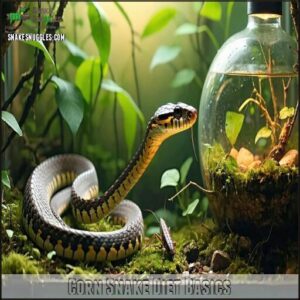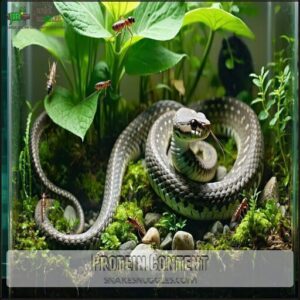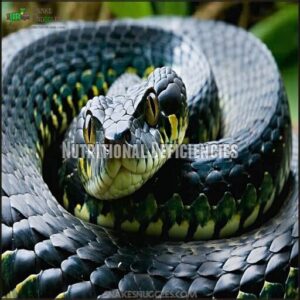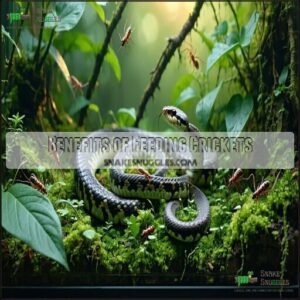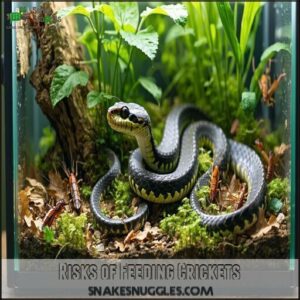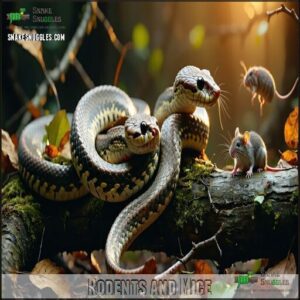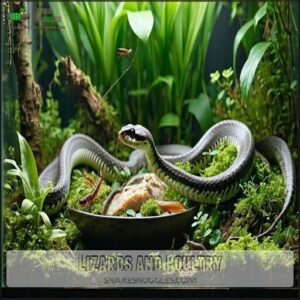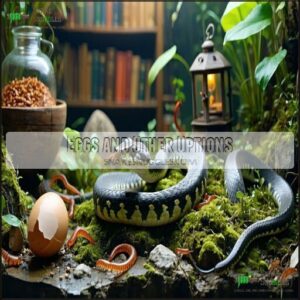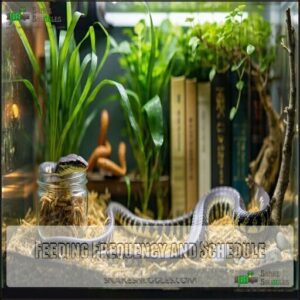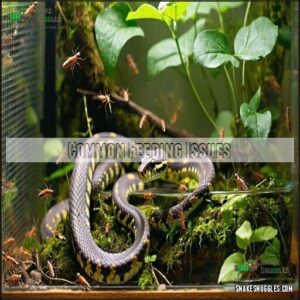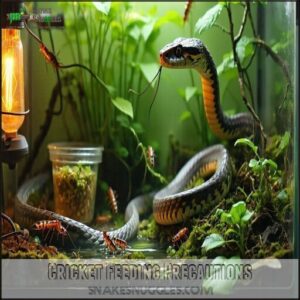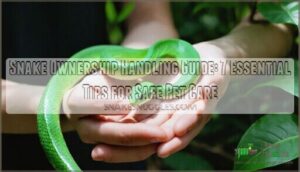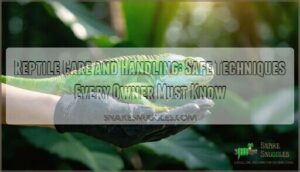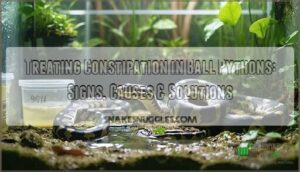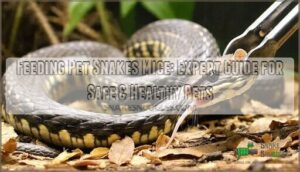This site is supported by our readers. We may earn a commission, at no cost to you, if you purchase through links.
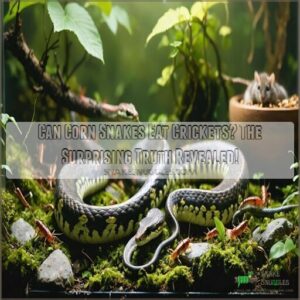 Wondering if corn snakes can eat crickets? Good news! These slithery friends can indeed munch on crickets as an occasional treat, but they’re not a complete meal ticket.
Wondering if corn snakes can eat crickets? Good news! These slithery friends can indeed munch on crickets as an occasional treat, but they’re not a complete meal ticket.
Crickets pack some protein and can provide enrichment, but they shouldn’t be your snake’s main course. As a carnivorous reptile, your corn snake craves whole prey like mice, which offer more complete nutrition.
While crickets can add variety to their diet, they’re more like a side dish than the main event. Think of them as a nutritional snack that keeps your snake interested and engaged, but not a dietary staple.
Intrigued? There’s more to learn about feeding these fascinating reptiles.
Table Of Contents
Key Takeaways
- You’ll want to treat crickets as an occasional snack, not a main course for your corn snake. While they provide some protein, they can’t replace the nutritional value of whole prey like mice.
- Your corn snake’s diet should primarily consist of rodents, with crickets offering minimal nutritional benefits. They’re more of a dietary supplement than a reliable food source.
- You’ll need to be cautious about potential risks when feeding crickets, including digestive issues like impaction and nutritional imbalances. The hard exoskeleton of crickets can cause problems for your snake’s digestive tract.
- Always monitor your snake’s feeding response and consult a veterinarian to ensure a balanced diet. Variety is key, but whole prey remains the most important component of your corn snake’s nutritional needs.
Corn Snake Diet Basics
If you’re a corn snake owner, understanding your snake’s dietary needs is essential for its health and well-being.
Corn snakes are carnivorous predators that primarily consume whole prey, with rodents like mice forming the cornerstone of their nutritional intake.
Carnivorous Nature
Your corn snake isn’t just a pet—it’s a calculated predator hardwired for meat consumption.
These natural carnivores excel at prey capture through sophisticated hunting tactics embedded in their evolutionary design.
In the wild, corn snakes navigate complex food chains, using specialized techniques to forage and consume whole prey with remarkable precision and efficiency, making them successful carnivores.
Primary Food Sources
When exploring rodent options for your slithery friend, you’ll find mice are the main course in a corn snake’s diet.
These carnivorous hunters primarily feast on small rodents like mice and rats in both wild and captive settings.
The key to snake nutrition is understanding their prey variety and food quality, ensuring a balanced and satisfying meal plan.
Importance of Variety
A snake’s diet-variety strategy is vital for maintaining ideal health and preventing nutritional deficiencies.
By practicing prey rotation and embracing dietary diversity, you’ll support your corn snake’s digestive health and nutrient balance.
Varied food sources like crickets, rodents, and other protein options guarantee your pet receives essential nutrients, keeping them thriving and happy.
Can Corn Snakes Eat Crickets
If you’re wondering about adding crickets to your corn snake’s menu, you’ll want to tread carefully.
While these slithery pets primarily feast on rodents, crickets can occasionally make a surprise appearance in their diet.
Small crickets might seem like a tempting snack, but they’re not the main course.
Your snake’s digestive system is primed for larger prey, making crickets more of a side dish than a staple.
Feeding cricket-size protein to your snake requires careful consideration of Snake Nutrition and Digestive Health.
Pro feeding tip: always verify the cricket is appropriately sized and doesn’t become a choking hazard.
Remember, variety’s great, but stick to what your scaly friend knows best.
Cricket Nutritional Value
When considering crickets as a potential food source for your corn snake, you’ll want to understand their nutritional composition.
While crickets offer some nutrients, they can’t replace the primary dietary needs of your snake’s protein-rich diet of rodents.
Protein Content
When considering protein for your slithery friend, crickets pack a surprisingly potent punch.
These tiny hoppers deliver essential amino acids that support muscle development and overall health.
Why crickets matter for protein:
- Lean muscle maintenance
- Rapid growth support
- Efficient nutrient absorption
- Natural protein source
Macronutrient-rich crickets offer corn snakes valuable protein sources, ensuring balanced dietary needs with each crunchy bite, providing essential amino acids.
Vitamin and Mineral Content
After examining protein levels, let’s crack open the cricket’s vitamin and mineral profile.
These tiny hoppers pack a punch of calcium, helping maintain your corn snake’s bone health.
While cricket nutrition offers some dietary enrichment, they’re not a complete solution.
Calcium supplements might be necessary to prevent nutrient deficiency and support your snake’s essential amino acids needs.
Nutritional Deficiencies
By the time a corn snake reaches adulthood, malnutrition risks become critically apparent.
Understanding cricket nutrition reveals significant dietary gaps for reptiles.
Here’s what you need to know about nutritional deficiencies:
- Crickets lack essential nutrients for complete corn snake dietary needs
- Vitamin deficits can trigger metabolic complications
- Mineral lack impairs overall reptile health
- Nutrient imbalance leads to potential long-term damage
- Dietary gaps compromise snake’s immune system and growth potential
Benefits of Feeding Crickets
If you’re looking to diversify your corn snake’s diet, crickets can be an intriguing alternative to traditional rodent prey.
These tiny hoppers offer a convenient, stimulating food source that can provide nutritional variety and enrichment for your slithery companion, with enrichment being a key aspect of their care.
Convenient Food Source
Crickets emerge as a convenient food option for corn snake owners, offering quick and easy meal replacements.
These tiny insects provide feeding ease and dietary flexibility, allowing you to quickly stock up on crickets without the hassle of larger prey.
They’re a simple solution when traditional rodent food sources are unavailable, giving snake owners a practical backup plan.
Understanding the importance of proper nutrient supplementation is essential for the health and well-being of corn snakes, and provides a key aspect of dietary flexibility.
Exercise and Stimulation
Perk up your corn snake’s lifestyle by introducing crickets as a stimulating food source! Environmental enrichment can truly transform your pet’s well-being through active engagement.
Consider these exciting benefits:
- Habitat exploration encourages natural hunting behaviors
- Physical activity increases through interactive feeding
- Mental stimulation keeps your snake alert and engaged
- Sensory experiences provide essential snake health tips
Using a reliable cricket food source is essential for a balanced diet, and it supports the overall well-being of your pet through environmental enrichment.
Low Cost
After sparking your snake’s hunting instincts, crickets offer budget-friendly feeding that won’t break the bank.
Crickets: Nature’s cheap and cheerful snake snack that keeps wallets and reptiles equally happy!
These tiny insects are cheap prey for corn snakes, providing an economical diet option.
With low-cost crickets, you’ll save money while giving your slithery friend a nutritious meal.
Budget-conscious snake owners can rejoice in this affordable food source that keeps both wallet and reptile happy.
Risks of Feeding Crickets
When feeding crickets to your corn snake, you’ll want to understand the potential risks that come with this alternative prey option.
While crickets might seem like a convenient snack, they can pose significant nutritional and health challenges for your serpentine companion, which is a crucial consideration for health.
Nutritional Imbalance
While those cricket treats seemed like a handy snack, they’re not the nutritional powerhouse your corn snake needs.
Malnutrition risks loom large when crickets become a primary diet. Dietary deficits can wreak havoc on your snake’s health, leaving nutrient gaps that compromise their entire metabolic system.
A varied diet is your reptile’s lifeline.
Health Issues
When nutritional imbalances persist, health issues can quickly spiral for your corn snake.
Impaction risks rise with cricket consumption, potentially blocking your snake’s digestive tract. Watch for warning signs like lethargy, weight loss, and irregular bowel movements.
These digestive problems can lead to serious feeding disorders and compromise your snake’s overall well-being if left unchecked, potentially causing long-term damage to its digestive tract.
Behavioral Problems
If stress signs emerge during cricket feeding, your corn snake might experience behavioral issues that disrupt its normal routine.
Watch for these potential problems:
- Snake aggression during feeding frenzies
- Handling difficulties with finicky eaters
- Potential disinterest in prey due to environmental enrichment challenges
Understanding these behavioral nuances helps maintain your snake’s health and feeding response, preventing long-term nutritional complications.
Alternative Food Sources
If you’re looking to expand your corn snake’s menu beyond crickets, you’ll be glad to know there are plenty of alternative food sources to keep your slithery friend healthy and satisfied.
From mice and lizards to eggs and poultry, you’ll discover a variety of nutritious options that can provide essential nutrients and maintain your corn snake’s ideal diet.
Rodents and Mice
Every discerning corn snake owner knows mice are the gold standard for feeding.
Mice reign supreme—the perfect protein package for your corn snake’s culinary delight.
Carefully selected rodents match your snake’s natural hunting strategies, providing key nutrition and mimicking wild prey selection.
Mice breeds like feeder mice offer perfectly sized meals, ensuring your corn snake receives balanced nutrients without risking digestive complications or overfeeding.
For superior snake care, understanding feeder mouse nutrition is vital, involving mouse food sources, which is crucial for providing the right nutrition and ensuring the snake’s health by mimicking wild prey selection.
Lizards and Poultry
If you’re exploring unique protein sources for your corn snake, lizards and poultry might surprise you as alternative exotic pet food options.
While not their primary diet, these protein-rich foods can occasionally supplement a corn snake’s nutrition.
Carefully selected small lizards or poultry pieces can provide essential nutrients, but always consult a reptile veterinarian to confirm proper dietary balance, ensuring a well-rounded and nutrition plan that includes protein-rich foods.
Eggs and Other Options
When considering diversifying your corn snake’s diet, eggs and other protein-rich options can be game-changers.
Consider these five alternative food sources:
- Quail eggs
- Earthworms
- Frog legs
- Superworms
- Fish food
While crickets remain a popular choice, these alternatives provide essential nutrients and keep your snake’s meals interesting.
Always consult a reptile veterinarian to verify balanced nutrition for your scaly friend.
Feeding Frequency and Schedule
Understanding your snake’s feeding schedule is essential for its health and well-being.
You’ll want to tailor your feeding routine to your corn snake’s age, size, and metabolic needs, ensuring ideal nutrition without overfeeding, which is crucial for its overall well-being.
Hatchlings and Juveniles
Young corn snakes need careful feeding strategies during their hatchling and juvenile stages.
Feeding frequency is critical for proper snake care, with experts recommending meals every 5-7 days.
Juvenile snakes require appropriately sized prey, typically small mice that match their body width.
Growth rates depend on consistent nutrition, ensuring healthy corn snake development and supporting robust juvenile health.
Adults and Seniors
Mature corn snakes demand strategic dietary management. As your serpent companion enters its golden years, reduce feeding frequency to once every 4-6 weeks, prioritizing nutrient-dense rodents over crickets.
Aging snakes metabolize food slower, so monitor weight closely and adjust portions. Senior snake care means balancing nutritional needs with careful observation of your reptile’s changing health and appetite.
Understanding the proper feeding schedule guidelines is vital for maintaining healthy health in mature corn snakes.
Adjusting Frequency
Metabolism and growth stages substantially influence your corn snake’s feeding schedule. As snakes age, their digestion rates and nutritional needs change dramatically.
- Adjust meal intervals based on the snake’s current size and activity level
- Monitor weight and body condition regularly
- Consult a veterinarian for personalized feeding schedules
Tailoring food consumption guarantees healthy development and prevents potential digestive complications during different life phases, which is crucial for the snake’s overall well-being.
Common Feeding Issues
If you’re a corn snake owner, you’ve likely encountered feeding challenges that can leave you feeling frustrated and uncertain.
Understanding these common feeding issues is essential for maintaining your snake’s health and preventing potential nutritional complications that could impact its long-term well-being.
Regurgitation and Food Strikes
When food refusal strikes, your corn snake might send you a clear signal: something’s wrong.
Regurgitation issues often stem from feeding stress or improper prey handling.
Watch for signs like repeated food strikes, which could indicate digestive problems or underlying health concerns.
Careful observation and gentle feeding techniques can help prevent these uncomfortable snake feeding challenges, often related to improper prey handling.
Overweight and Underweight
After battling regurgitation issues, monitoring your corn snake’s body condition becomes paramount. Weight management is key to their health.
Here’s what you need to know:
- Watch for fat rolls near the tail base
- Check for a "loaf-like" body shape
- Avoid visible spine or tented back
- Recognize obesity signs early
- Maintain balanced corn snakes diet
Keeping your snake at a healthy weight prevents serious health complications.
Aggressive Behavior
Feeding crickets to corn snakes can trigger unexpected aggressive behavior.
Watch for stress signals like hissing or defensive coiling during mealtime.
Snake fights often stem from territorial defense or feeding aggression, which can lead to bite injuries.
If your snake becomes overly aggressive, separate food sources and minimize handling during feeding to prevent potential conflicts.
Understanding proper snake feeding habits is essential to avoid such issues related to snake feeding.
Cricket Feeding Precautions
While crickets might seem like an appealing food option for corn snakes, you’ll want to be cautious about potential risks.
Understanding the specific feeding precautions can help you protect your snake’s health and prevent digestive complications, which is crucial for maintaining the overall well-being of your snake’s health.
Impaction and Digestive Issues
After wrestling with feeding challenges, corn snake owners must watch for digestive blockage risks from crickets.
Their hard exoskeleton can cause intestinal issues, potentially leading to impaction—a dangerous bowel obstruction where the digestive tract becomes completely blocked.
Low temperatures and indigestible cricket parts increase gut health complications, making careful monitoring essential for preventing serious feeding problems.
Understanding proper snake feeding techniques is vital to avoid these serious feeding problems.
Risk of Injury
When crickets become a wrestling match for your corn snake, injury risks emerge.
Watch out for these potential hazards:
- Sharp cricket legs can puncture sensitive snake skin
- Live crickets might nip or scratch during feeding
- Aggressive insects could cause mouth or throat wounds
- Improper size mismatch leads to choking hazards
Monitoring feeding closely prevents digestive issues and minimizes impaction risks, keeping your slithery friend safe from unexpected cricket-induced injuries.
Using proper snake feeding tools is essential for a safe feeding experience.
Frequently Asked Questions (FAQs)
What do corn snakes eat?
You’ll feast your corn snake on a diet of small rodents like mice and rats.
Their carnivorous nature means they’ll gobble up whole prey that matches their body width, ensuring a nutritious and satisfying meal in captivity or the wild, with their diet consisting of small rodents being a key aspect of their nutritious meal.
Do corn snakes eat crickets?
Ironically, while crickets might seem like a tempting snack, they’re not an ideal meal for your corn snake.
You’ll want to stick to mice and rats for a nutritionally complete diet that meets your slithery friend’s needs.
Can snakes eat crickets?
While some snakes will eat crickets in captivity, they’re not a nutritionally complete diet.
You’ll want to focus on whole prey like mice, which provide essential proteins and nutrients that crickets can’t fully supply for your snake’s health.
Can corn snakes eat chicken?
When in Rome, do as the Romans do—but with chicken, not for corn snakes.
You’ll want to stick to their natural diet of mice and rats.
Chicken isn’t a safe or nutritionally appropriate food source for these reptiles.
Can corn snakes eat humans?
No, corn snakes can’t eat humans.
They’re far too small to consume an adult or child.
While they’re carnivorous predators, their diet consists of small rodents like mice, not large mammals or humans.
Can corn snakes eat mice?
Picture a hungry serpent, coiled and ready to strike.
You’ll find mice are a corn snake’s primary meal—in the wild or captivity.
They’re nutritionally perfect, offering the protein and sustenance these reptiles need for survival and growth.
Can a corn snake survive on a vegetarian diet?
No, a corn snake can’t survive on a vegetarian diet.
They’re strict carnivores that require whole prey like mice or rats to obtain essential nutrients.
Your snake needs animal protein to maintain its health and survive.
Can corn snakes eat chicken eggs?
Like a hungry hunter sizing up its prey, you’ll find corn snakes can’t digest chicken eggs.
Their carnivorous diet requires whole prey animals, not protein sources like eggs, which lack essential nutrients for their survival.
Do corn snakes eat at night?
You’ll typically find corn snakes hunting at night, leveraging their excellent night vision and heat-sensing abilities to track down prey.
Their nocturnal nature helps them avoid predators and take advantage of active rodent movement during dark hours, utilizing their heat-sensing abilities.
What else can I feed my corn snake?
You’ll want to mix up your corn snake’s diet with mice, rats, and occasionally small birds or eggs.
Store-bought frozen prey works best, ensuring balanced nutrition and easy feeding for both you and your slithery friend.
Conclusion
As reptile keepers, you’ll find that only 15% of corn snake owners regularly supplement their diet with crickets.
When considering can corn snakes eat crickets, remember they’re a nutritional bonus, not a dietary staple.
You’ll want to balance occasional cricket treats with whole prey like mice.
Your snake’s health depends on a varied, protein-rich diet.
While crickets can provide enrichment, they shouldn’t replace essential nutrition.
Always consult a veterinarian to optimize your corn snake’s dietary plan.

